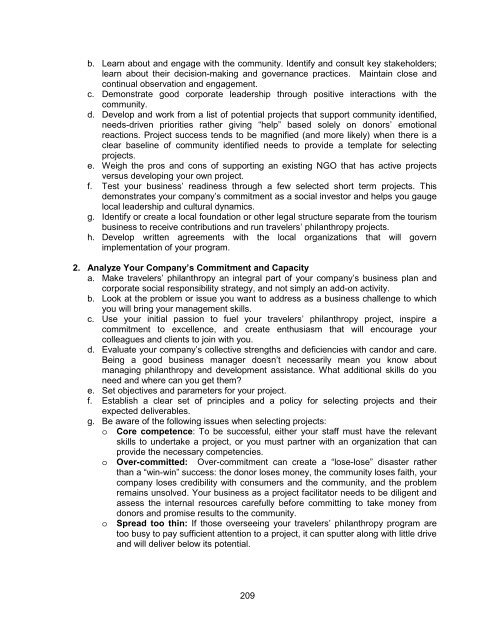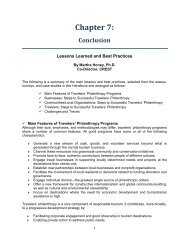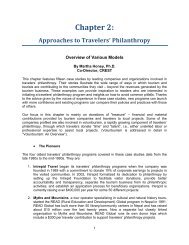Travelers' Philanthropy Handbook - Center for Responsible Travel
Travelers' Philanthropy Handbook - Center for Responsible Travel
Travelers' Philanthropy Handbook - Center for Responsible Travel
You also want an ePaper? Increase the reach of your titles
YUMPU automatically turns print PDFs into web optimized ePapers that Google loves.
. Learn about and engage with the community. Identify and consult key stakeholders;learn about their decision-making and governance practices. Maintain close andcontinual observation and engagement.c. Demonstrate good corporate leadership through positive interactions with thecommunity.d. Develop and work from a list of potential projects that support community identified,needs-driven priorities rather giving “help” based solely on donors’ emotionalreactions. Project success tends to be magnified (and more likely) when there is aclear baseline of community identified needs to provide a template <strong>for</strong> selectingprojects.e. Weigh the pros and cons of supporting an existing NGO that has active projectsversus developing your own project.f. Test your business’ readiness through a few selected short term projects. Thisdemonstrates your company’s commitment as a social investor and helps you gaugelocal leadership and cultural dynamics.g. Identify or create a local foundation or other legal structure separate from the tourismbusiness to receive contributions and run travelers’ philanthropy projects.h. Develop written agreements with the local organizations that will governimplementation of your program.2. Analyze Your Company’s Commitment and Capacitya. Make travelers’ philanthropy an integral part of your company’s business plan andcorporate social responsibility strategy, and not simply an add-on activity.b. Look at the problem or issue you want to address as a business challenge to whichyou will bring your management skills.c. Use your initial passion to fuel your travelers’ philanthropy project, inspire acommitment to excellence, and create enthusiasm that will encourage yourcolleagues and clients to join with you.d. Evaluate your company’s collective strengths and deficiencies with candor and care.Being a good business manager doesn’t necessarily mean you know aboutmanaging philanthropy and development assistance. What additional skills do youneed and where can you get them?e. Set objectives and parameters <strong>for</strong> your project.f. Establish a clear set of principles and a policy <strong>for</strong> selecting projects and theirexpected deliverables.g. Be aware of the following issues when selecting projects:oCore competence: To be successful, either your staff must have the relevantskills to undertake a project, or you must partner with an organization that canprovide the necessary competencies.o Over-committed: Over-commitment can create a “lose-lose” disaster ratherthan a “win-win” success: the donor loses money, the community loses faith, yourcompany loses credibility with consumers and the community, and the problemremains unsolved. Your business as a project facilitator needs to be diligent andassess the internal resources carefully be<strong>for</strong>e committing to take money fromdonors and promise results to the community.oSpread too thin: If those overseeing your travelers’ philanthropy program aretoo busy to pay sufficient attention to a project, it can sputter along with little driveand will deliver below its potential.209















